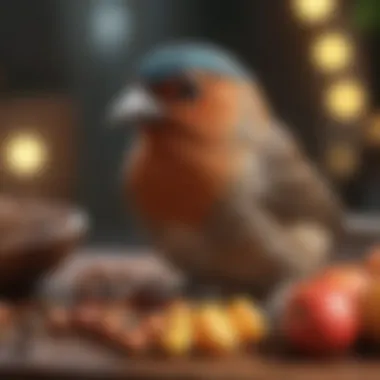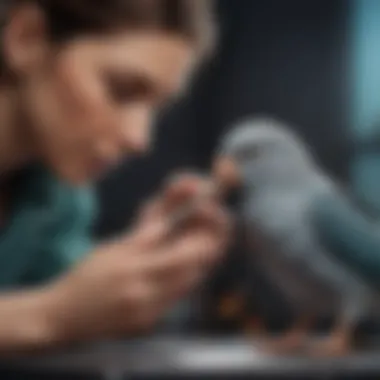Lifespan Insights: Understanding Pet Bird Longevity


Intro
Care Tips
Daily Care Routines
Creating a consistent care routine can greatly impact your bird's lifespan. Interact with your bird every day. This interaction comforts them and contributes positively to their mental health. Time spent bonding can also aid in recognizing any changes in behavior, which could signal health issues. Ensure healthy feed and fresh water at all times.
Cage Setup and Maintenance
A well-maintained cage is vital for your bird’s wellbeing. Choose the right size and type of cage based on your bird's needs. Place the cage in a draft-free location, away from direct sunlight but with good airflow.
An essential part of the maintenance is cleaning the cage regularly. Remove droppings, uneaten food, and spent bedding daily. Full cage cleaning should be weekly, using bird-safe cleaning supplies to prevent chemical exposure.
Hygiene and Cleaning Practices
Regular grooming contributes to your bird's overall health. Feather care can prevent skin issues. Bathing your bird can help with feather management. Natural baths or misting with water can be beneficial.
Seasonal Care Adjustments
Every season brings its own set of challenges for pet birds. In colder months, ensure they have adequate warmth. In warm weather, be mindful not to expose them to heat stress. Adjust their environment accordingly. During seasonal changes, monitor your bird's behavior. Any significant shifts may require a re-evaluation of their care routine.
Behavioral Insights
Understanding your bird's body language enables better communication. Notice certain behaviors. Playfulness can indicate a happy bird, while excessive screaming may signal stress or boredom.
Observing everyday social interactions is key. Birds are inherently social creatures. Adequate social stimulation will affect their mental health positively. If issues arise, like feather plucking or excessive aggression, seek behavioral feedback from an avian specialist. After identifying concerns, implementing positive reinforcement techniques can help rectify negative behavior.
The time spent forming this understanding creates a bond necessary for happy birds.
Nutrition Guides
Essential Diet Components
Every species requires a specific dietary blend to maintain their wellbeing. Most birds thrive on a balanced belly of seeds, pellets, vegetables, and fruits. Ensure the availability of fresh produce daily.
Safe and Toxic Foods
Some foods pose obvious threats to feathered companions. Examples include chocolate, avocado, and caffeine. Always research food safety before introducing new items.
Supplements and Treats
While a good diet often suffices, incorporating supplements like omega-3 fatty acids can help ensure your bird gets all necessary nutrients. Selecting safe treats is also beneficial. Enjoy giving treats with moderation.
Wellness and Health
Routine Health Checkups
Establish a relationship with an avian vet for regular check-ups. Preventative care is essential for monitoring bird's health, spotting issues before they become serious.
Identifying Symptoms of Illness
Birds cannot voice discomfort as humans do. Early signs can include changes in appetite, disruption in normal singing, or frequent hiding behavior. Knowing the behavioral patterns of one's pet aids this recognition.


Preventative Care and Vaccinations
Vaccinating your bird protects it from common avian diseases. Vaccination schedules will vary by species, so consultation with a veterinarian is important.
Mental and Emotional Well-being
Birds experience stress and anxiety. Recognizing and removing triggers is paramount. Providing a proper environment nurtures mental health, rewarding the effort with increased overall well-being.
Enriching Activities
Toys and Playtime Ideas
Social interaction and mental stimulation help prolong your pet bird’s lifespan. Rotate toys to avoid boredom. They should cater to your bird's natural instincts, such as foraging or climbing.
Training and Tricks
Training can significantly blend play and discipline. Simple tricks, like giving a high-five, provides comfort. Both the pet and the owner benefit from interactive training sessions.
Outdoor Activities and Interaction
With proper supervision, bringing birds outdoors can expose them to new sights and sounds. Fresh air is invigorating. Gradually introduce birds to the outside. Early and controlled interaction builds confidence.
DIY Projects for Mental Stimulation
Simple DIY can bring fresh excitement. Creating foraging toys out of safe materials enables exploration and guards against boredom. Engage creativity, giving your pet opportunities to explore their environment with a fresh perspective.
Maintaining awareness of your bird's habits and tendencies is crucial for nurturing a long and healthy life. By integrating thoughtful care practices and enriching activities, owners can enhance your avian friend's wellbeing and life expectancy.
Overview of Pet Bird Lifespan
General Lifespan Trends
Pet birds exhibit a wide range of lifespan trends influenced by several factors, including species, genetics, and living conditions. Generally, smaller birds, like parakeets and canaries, tend to life shorter lives averaging around 8 to 15 years. In contrast, larger breeds, such as Amazon or African Grey parrots, can live significantly longer, some even reaching 50 years or more. Therefore, it's essential for prospective bird owners to consider these general lifespan trends for optimal planning and care.
Importance of Lifespan Awareness
Being aware of a pet bird's potential lifespan informs various decisions regarding care. This knowledge influences owners in choosing the proper diet, setting up an ideal environment, and scheduling regular veterinary check-ups. By understanding that certain species have longer lifespans, bird owners can alter their long-term plans, incorporating aspects such as family dynamics and availability of resources over the years.
"Preparedness for a pet's lifespan can enhance both the owner's experience and the bird's quality of life."
This awareness is also essential for promoting the welfare of our avian companions, ensuring they receive attentive care and preventive measures against disease and discomfort. Owners must reflect on these aspects to create an enriching life for their birds, benefiting both parties involved.
Factors that Influence Lifespan
Understanding the factors that influence the lifespan of pet birds is crucial for any avian owner. Different elements work together to define how long these creatures thrive. Addressing these factors may improve the quality of life for pet birds. Owners can also use the information to create an environment that maximizes longevity.
Genetics and Species Variation
Genetics plays a significant role in dictating the lifespan of a bird. Various species have different life expectancies due to their genetic makeup. For instance, a parakeet usually lives for around 5 to 10 years, while an African Grey can live for 30 years or more. Species variation is an essential consideration when choosing a pet bird. Owners need to be aware that some species may have inherited conditions that can impact health. Researching specific breeds enhances knowledge for prospective bird owners.
Environmental Conditions
A bird's environment can heavily influence its lifespan. Factors such as cage size, temperature, and humidity are applicable. Moreover, the presence of pollutants or toxins can harm birds over time. Birds thrive in clean surroundings with adequate ventilation and lighting. Owners should ensure that their avian companions can express natural behaviors. Enrichment in their habitat, including toys and perches, is also vital to promote physical and mental well-being.


Diet and Nutrition
Birds require a balanced and nutritious diet to live longer, healthier lives. Poor nutrition can lead to a range of health issues such as obesity and organ failure. Incorporating fresh fruits, vegetables, seeds, and special pellets can ensure a comprehensive intake of nutrients. It’s crucial to research the dietary needs specific to each bird species. For example, cockatiels need calcium from cuttlebone or mineral blocks. Proper feeding practices significantly influence the duration of life for pet birds.
Health Care and Veterinary Support
Regular veterinary care is instrumental in extending a bird's life. Routine check-ups help to catch health problems early. Veterinary support should include vaccinations, grooming, and nutritional advice. Access to an avian veterinarian is essential, especially as some regular vets may not have enough experience with bird-specific issues. Comprehensive healthcare contributes favorably to longevity, allowing any health issues to be addressed proactively.
Ensuring each aspect of a bird's life is carefully managed will lead to a healthier, longer life.
Species-Specific Lifespan
Understanding the species-specific lifespan of pet birds is of utmost importance for owners, breeders, and avian enthusiasts. Different species exhibit varied life expectancies due to genetic, environmental, and behavioral factors. Knowing the average lifespan of a specific species can help owners cater to their bird's needs effectively, making informed decisions related to care, nutrition, and health management. It enables the bird owner to anticipate appropriate veterinary care and create optimal living conditions.
Parakeets
Parakeets, often colorful and lively, typically have a lifespan ranging between seven to fifteen years. Their life expectancy heavily depends on their living environment and healthcare. Providing them with a balanced diet, rich in seeds and greens, can enhance their well-being significantly. Parakeets are social animals and thrive in stimulating environments, including toys and activities that prevent boredom.
Cockatiels
Cockatiels can live anywhere from ten to fourteen years. These birds are particularly prone to respiratory illnesses, which can shorten their lifespan. Regular check-ups with a veterinarian, maintaining air quality, and providing a varied diet can contribute significantly to their longevity. Additionally, engaging them in both mental and physical activities is crucial, as they require stimulation for optimal health.
Lovebirds
The lifespan of lovebirds typically ranges from ten to fifteen years. These birds are social and need companionship, either from humans or other birds. Ensuring they have enough social interaction and a proper diet rich in fruits and vegetables will help them stay healthy. It's essential to be aware of their potential for territorial behavior, especially evaluating their compatibility with other pets.
Canaries
Canaries usually live around ten to fifteen years. These birds tend to be more solitary but greatly benefit from an adequately sized cage and a balanced diet rich in seeds, greens, and special treats. Canaries are sensitive to environmental conditions, so ensuring proper ventilation and cleanliness will help avoid issues that could affect their longevity.
Amazon Parrots
Amazon parrots can live a significantly long time, averaging around 25 to 50 years. It is vital for owners to cater to their intelligence with an environment rich in enrichment activities and toys. Their social nature demands interaction, while proper dietary practices play a major role in their overall health, emphasizing the need for fresh fruits and fortified pellets in their diet.
African Grey Parrots
The lifespan of African Grey parrots can span 20 to 40 years. This intelligence comes with its own set of challenges, requiring mental stimulation to avoid behavioral issues. They thrive on companionship and often form strong bonds with their owners. The importance of a nourishing diet cannot be overstated; it is critical for their long-term health and cognition.
Macaws
Macaws can expect to live between 20 to 50 years, depending on species and care practices. Providing these large birds with spacious environments and appropriately varied diets can enhance their quality of life. Regular interaction and the stimulation are essential due to their high intelligence and active nature.
Budgerigars
Budgerigars, commonly known as budgies, tend to live between 5 to 15 years. They require social interaction and mental stimulation as they are playful and curious creatures. A vibrant environment, along with a proper diet, greatly influences their well-being. It is essential to provide toys and opportunities for exercise to promote a longer, healthy life.
Understanding the different lifespans associated with various bird species assists owners in making informed decisions to provide the best for their pets.
Enhancing Bird Longevity
Enhancing the longevity of pet birds is crucial for ensuring that they lead vibrant, fulfilling lives. The well-being and lifespan of these companions depend on several factors that owners can control. By focusing on creating a suitable environment, addressing nutritional needs, performing routine health checks, and providing mental and physical stimulation, bird owners can potentially decrease the risk of common health issues and promote a longer life.
Creating a Stimulating Environment


A stimulating environment can significantly affect a bird's happiness and lifespan. Pet birds need a space that encourages exploration, interaction, and activity. Key elements include:
- Placement of Cage: Situate the cage in a high-traffic area where the bird can see family activities. This can help keep the bird mentally stimulated and reduce feelings of isolation.
- Toys and Activities: Frequent rotation of toys prevents boredom. Include swing, climbing features, and varieties of toys tailored to the bird's species.
- Social Interaction: Birds are social creatures. Spending time with them daily fosters social skills and emotional well-being, contributing to a more satisfied, healthier bird.
Nutritional Strategies
Diet plays a pivotal role in a bird's longevity. Offering a balanced diet tailored to the specific needs of the species can reduce the risk of nutritional deficiencies. Important considerations include:
- High-Quality Pellets: Look for brand-formulated pelleted diets specific to the bird type.
- Fresh Fruits and Vegetables: Dark leafy greens and colorful vegetables offer essential vitamins. Regularly introduce a variety to keep meals interesting.
- Seeds and Treats: While seeds can be a part of the diet, fruits
Common Health Issues Impacting Lifespan
Understanding common health issues that affect pet birds is crucial for ensuring a longer and more fulfilling life for these companions. Health problems can drastically reduce lifespan and quality of life. By knowing these issues, bird owners can adopt proactive measures to mitigate risks and enhance the well-being of their avian friends.
Nutritional Deficiencies
Nutritional deficiencies are one of the critical issues affecting the lifespan of pet birds. Many birds rely on a diet that lacks essential vitamins and minerals, which can lead to soft feathers, distorted bones, or weakened immune systems. Common deficiencies include Vitamin A, calcium, and essential fatty acids. It's vital to ensure a balanced diet that incorporates a variety of foods. For instance, fresh fruits, vegetables, and high-quality pellets should be staple components in their meal plan. Supplements can also play a role in covering gaps when necessary. Monitoring your pet’s eating habits and adjusting their diet promptly is essential for their longevity.
Obesity and Related Complications
Obesity amongst pet birds has become increasingly common due to sedentary lifestyles and poor dietary choices. Overfeeding or offering an excessive amount of high-fat seeds is a usual culprit. An overweight bird faces various complications like heart disease, arthritis, and issues related to reproduction. Managing their weight is important, which involves offering portion-controlled feeding and encouraging physical activity. Providing toys that prompt movement or designing a safe space where they can exercise freely can significantly assist in maintaining a healthy weight.
Respiratory Issues
Respiratory issues are prevalent in pet birds and can be life-threatening. Birds have delicate respiratory systems, susceptible to the quality of the environment. Factors such as temperature extremes, poor ventilation, and exposure to airborne irritants like smoke or mold can contribute. Proper housing that ensures cross-ventilation and limits exposure to toxins should be priorities. Regular veterinary check-ups can help identify early signs of respiratory distress. A knowledgeable bird owner should be attentive to their pet’s breathing patterns.
Behavioral Disorders
Behavioral disorders among pet birds often stem from a lack of social interaction or inadequate environmental enrichment. Issues like plucking feathers, screaming excessively, or aggressive patterns can emerge due to boredom or stress. Providing social interactions through talking, training sessions, and allowing socialization with other birds can foster mental well-being. Moreover, providing a stimulating environment with assorted toys, perches, and opportunities for exploration should be essential aspects of their care regimen. Proper attention to these disorders can assist in ensuring that behavior does not compromise their health and longevity.
Understanding these common health issues equip pet bird owners with the tools to significantly improve their pets' lives.
Adopting an informed approach can substantially impact the overall health and lifespan of pet birds. By addressing these issues and custom tailoring their care, owners can enhance their birds’ chances for a long and healthy life.
Comparative Lifespan Studies
Importance of Comparative Lifespan Studies
Comparative lifespan studies are essential for understanding how various factors affect the longevity of pet birds. These studies allow bird owners and researchers to analyze how different environments, diets, and care practices can influence avian life expectancy. By gaining insights into these elements, one can make informed decisions about how to structure care regimens for their birds. Knowing how lifespan differs between birds in captivity and their counterparts in the wild is one of the crucial aspects of these studies. It clarifies the impact of human intervention on natural behaviors and health.
Analysis of Lifespan in Captivity vs.
Wild
When examining lifespan, the disparities between captive and wild bird species become evident. Captive birds often live significantly longer than those in the wild. In captivity, advantages such as better nutrition, absence of predators, and regular veterinary care can extend a bird's life. For instance, many parakeets in captivity can often reach 10 to 15 years, whereas in the wild, predation and food scarcity can limit their lifespan to less than that. Environmental stressors like air pollution and disease pose additional risks for wild birds.
However, while captivity offers a safer method of survival, it may also present unique challenges. Behaviorally, captive birds might experience frustration due to lack of space and enrichment. Distressing conditions in captivity can lead to chronic health problems, negating some of the lifespan advantages. Understanding both sides helps in grasping the entirety of avian life expectations, enabling pet bird owners to provide suitable living conditions that promote healthier lives.
Case Studies of Specific Species
Delving into specific case studies of various pet bird species helps to further illustrate the impressive differences in lifespan. For example:
- African Grey Parrots are noted for their intelligence and can live over 50 years in human care, surpassing their average lifespan of roughly 20 years in the wild, primarily attributed to better nutrition.
- Budgerigars, commonly known as budgies, usually live up to 7 years in the wild but can thrive for more than 15 years with proper care.
In examining these case studies, one can assess how aspects such as diet, socialization, habitat, and healthcare practices significantly influence these results. These insights enable pet bird owners to adopt practices that can extend the lives of their birds. More research and observations of individual species continue to be crucial in illuminating the impacts of their environments and care.
Proper care and stimulation can result in notable improvements in avian lifespans, emphasizing the need for more informed and careful handling by bird owners.
Implications for Bird Owners
This long-term commitment also means being aware of the major stages of a bird's life, from the lively youth of a chick to the mellower but more demanding phases of seniority. Understanding this gives owners a better perspective on when to adapt care, ensuring the emotional and physical well-being of their birds throughout their lives.















